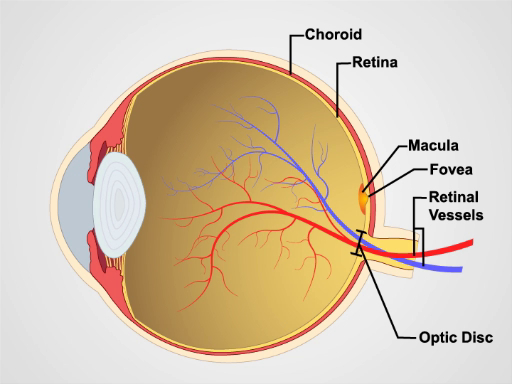Ophthalmoskopie
Überblick
Quelle: Richard Glickman-Simon, MD, Assistant Professor, Department of Public Health and Community Medicine Tufts University School of Medicine, MA
Die einfachste Ophthalmoskope bestehen aus eine Öffnung, durch zu schauen, eine Dioptrien-Indikator und eine Disc für die Auswahl der Linsen. Das Ophthalmoskop dient in erster Linie prüfen des Augenhintergrundes, oder die Innenwand des hinteren Auge, bestehend aus der Aderhaut, Netzhaut, Fovea, Makula, Papille und Netzhautgefäße ()Abbildung 1). Der kugelförmige Augapfel sammelt und bündelt das Licht auf die neurosensorischen Zellen der Netzhaut. Licht wird gebrochen, als es die Hornhaut, die Linse und den Glaskörper nacheinander durchläuft.
Das erste Wahrzeichen beobachtet während der Funduscopic-Prüfung ist die Papille, die ist, wo der Sehnerv und die Netzhautgefäße geben Sie die Rückseite des Auges (Abbildung 2). Die CD enthält in der Regel eine zentrale weißliche physiologische Tasse wo die Schiffe eingeben; Es nimmt normalerweise weniger als der halbe Durchmesser des gesamten Datenträgers. Nur seitlich und leicht unterlegen ist die Fovea, eine abgedunkelten Kreisfläche, die den Punkt des zentralen Sehvermögens abgrenzt. Darum ist die Macula. Ein blinder Fleck ca. 15 ° zeitliche auf der Linie der Blick ergibt sich aus einem Mangel an Sehzellen an der Papille.

Abbildung 1: Anatomie des Auges. Das Diagramm zeigt eine sagittale Ansicht des menschlichen Auges mit den Strukturen gekennzeichnet.

Abbildung 2: normale Netzhaut. Ein Foto zeigt einen ophthalmoskopischen Blick auf die normale Netzhaut.
Verfahren
Da mydriatic Auge Tropfen sind in der Regel nicht im allgemeinen Praxis verwendet, ist die Ansicht des Augenhintergrundes beschränkt sich auf nur einen Abschnitt der hinteren Netzhaut. Mit diesen Funktionen vertraut sein, bevor Sie versuchen, den Patienten zu untersuchen.
- Es sei denn, der Patient Fehlsichtigkeiten es schwierig machen, auf der Netzhaut zu konzentrieren, ist es normalerweise am besten, Ihre eigene Brille für die Prüfung zu entfernen.
- Schalten Sie nach den Raum abdunkeln das Ophthalmoskop und Leuchten Si
Anwendung und Zusammenfassung
Die augenärztliche Untersuchung ist wahrscheinlich die größte Herausforderung für Studierende zu meistern. Mit der Zeit jedoch wird es Routine. Es ist auch eines der produktivsten Teile die körperliche Untersuchung, wie es nicht nur ein Fenster in den Zustand des Auges bietet, sondern auch der Erkrankung an anderer Stelle im Körper bietet. Erhöhter intrakranialen Druck aus einer Vielzahl von Ursachen führen zu Schwellung des Sehnerven, die als Papillenschwellung auf eine Funduscopic-Prüfung erscheint. In Papille...
pringen zu...
Videos aus dieser Sammlung:

Now Playing
Ophthalmoskopie
Physical Examinations II
68.2K Ansichten

Augenuntersuchung
Physical Examinations II
77.5K Ansichten

Untersuchung der Ohren
Physical Examinations II
55.4K Ansichten

Untersuchung der Nase, Nebenhöhlen, Mundhöhle und Rachen
Physical Examinations II
66.0K Ansichten

Untersuchung der Schilddrüse
Physical Examinations II
105.4K Ansichten

Überprüfung der Lymphknoten
Physical Examinations II
388.5K Ansichten

Abdominaluntersuchung I: Inspektion und Auskultation
Physical Examinations II
203.0K Ansichten

Abdominaluntersuchung III: Palpation
Physical Examinations II
248.6K Ansichten

Abdominal-Prüfung III: Palpation
Physical Examinations II
138.7K Ansichten

Abdominaluntersuchung IV: Beurteilung akuter abdominaler Schmerzen
Physical Examinations II
67.4K Ansichten

Männliche Rektaluntersuchung
Physical Examinations II
114.9K Ansichten

Umfassende Brustuntersuchung
Physical Examinations II
88.0K Ansichten

Gynäkologische Untersuchung I: Beurteilung der äußeren Genitalien
Physical Examinations II
308.9K Ansichten

Gynäkologische Untersuchung II: Spekulumuntersuchung
Physical Examinations II
150.8K Ansichten

Gynäkologische Untersuchung III: Bimanuelle und rektovaginale Untersuchung
Physical Examinations II
148.2K Ansichten
Copyright © 2025 MyJoVE Corporation. Alle Rechte vorbehalten